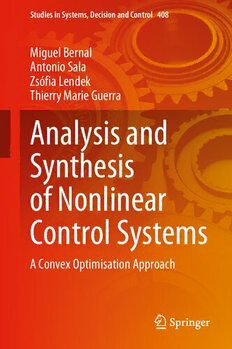Table Of ContentStudies in Systems, Decision and Control 408
Miguel Bernal
Antonio Sala
Zsófia Lendek
Thierry Marie Guerra
Analysis and
Synthesis
of Nonlinear
Control Systems
A Convex Optimisation Approach
Studies in Systems, Decision and Control
Volume 408
SeriesEditor
JanuszKacprzyk,SystemsResearchInstitute,PolishAcademyofSciences,
Warsaw,Poland
The series “Studies in Systems, Decision and Control” (SSDC) covers both new
developments and advances, as well as the state of the art, in the various areas of
broadly perceived systems, decision making and control–quickly, up to date and
withahighquality.Theintentistocoverthetheory,applications,andperspectives
on the state of the art and future developments relevant to systems, decision
making,control,complexprocessesandrelatedareas,asembeddedinthefieldsof
engineering,computerscience,physics,economics,socialandlifesciences,aswell
astheparadigmsandmethodologiesbehindthem.Theseriescontainsmonographs,
textbooks, lecture notes and edited volumes in systems, decision making and
control spanning the areas of Cyber-Physical Systems, Autonomous Systems,
Sensor Networks, Control Systems, Energy Systems, Automotive Systems,
Biological Systems, Vehicular Networking and Connected Vehicles, Aerospace
Systems, Automation, Manufacturing, Smart Grids, Nonlinear Systems, Power
Systems, Robotics, Social Systems, Economic Systems and other. Of particular
valuetoboththecontributorsandthereadershiparetheshortpublicationtimeframe
and the world-wide distribution and exposure which enable both a wide and rapid
disseminationofresearchoutput.
IndexedbySCOPUS,DBLP,WTIFrankfurteG,zbMATH,SCImago.
AllbookspublishedintheseriesaresubmittedforconsiderationinWebofScience.
Moreinformationaboutthisseriesathttps://link.springer.com/bookseries/13304
· · ·
Miguel Bernal Antonio Sala Zsófia Lendek
Thierry Marie Guerra
Analysis and Synthesis
of Nonlinear Control Systems
A Convex Optimisation Approach
MiguelBernal AntonioSala
DepartmentofElectricalandElectronics InstitutoUniversitariodeAutomáticae
Engineering InformáticaIndustrial
SonoraInstituteofTechnology UniversitatPolitècnicadeValència
Obregon,Sonora,Mexico Valencia,Spain
ZsófiaLendek ThierryMarieGuerra
DepartmentofAutomation DepartmentofAutomationandControl,
TechnicalUniversityofCluj-Napoca LAMIHUMRCNRS8201
Cluj-Napoca,Romania UniversitéPolytechniqueHauts-de-France
Valenciennes,France
ISSN2198-4182 ISSN2198-4190 (electronic)
StudiesinSystems,DecisionandControl
ISBN978-3-030-90772-3 ISBN978-3-030-90773-0 (eBook)
https://doi.org/10.1007/978-3-030-90773-0
MATLABisaregisteredtrademarkofTheMathWorks,Inc.Seehttps://www.mathworks.com/trademarks
foralistofadditionaltrademarks.
MathematicsSubjectClassification: 34H05, 37N35, 93B36, 93B51, 93C10, 93C35, 93D05, 93D09,
93D20,93D23,93D25,93D30,52A41,90C25,90C22,90C23
©TheEditor(s)(ifapplicable)andTheAuthor(s),underexclusivelicensetoSpringerNature
SwitzerlandAG2022
Thisworkissubjecttocopyright.AllrightsaresolelyandexclusivelylicensedbythePublisher,whether
thewholeorpartofthematerialisconcerned,specificallytherightsoftranslation,reprinting,reuse
ofillustrations,recitation,broadcasting,reproductiononmicrofilmsorinanyotherphysicalway,and
transmissionorinformationstorageandretrieval,electronicadaptation,computersoftware,orbysimilar
ordissimilarmethodologynowknownorhereafterdeveloped.
Theuseofgeneraldescriptivenames,registerednames,trademarks,servicemarks,etc.inthispublication
doesnotimply,evenintheabsenceofaspecificstatement,thatsuchnamesareexemptfromtherelevant
protectivelawsandregulationsandthereforefreeforgeneraluse.
Thepublisher,theauthorsandtheeditorsaresafetoassumethattheadviceandinformationinthisbook
arebelievedtobetrueandaccurateatthedateofpublication.Neitherthepublishernortheauthorsor
theeditorsgiveawarranty,expressedorimplied,withrespecttothematerialcontainedhereinorforany
errorsoromissionsthatmayhavebeenmade.Thepublisherremainsneutralwithregardtojurisdictional
claimsinpublishedmapsandinstitutionalaffiliations.
ThisSpringerimprintispublishedbytheregisteredcompanySpringerNatureSwitzerlandAG
Theregisteredcompanyaddressis:Gewerbestrasse11,6330Cham,Switzerland
Contents
1 Introduction ................................................... 1
References ..................................................... 3
2 ProblemstoBeSolvedandScopeoftheBook ..................... 5
2.1 SomeUsefulClassesofDynamicalSystems .................... 5
2.2 ControlObjectives .......................................... 8
2.3 Models ................................................... 11
2.3.1 ModelApproximations ............................... 12
2.3.2 ModelswithConvexStructure ......................... 13
2.4 TheConvex-StructureApproachtoControl:Motivation .......... 18
2.5 SummaryandConclusions ................................... 19
References ..................................................... 19
3 ModellingviaConvexStructures ................................ 23
3.1 Introduction ............................................... 23
3.2 Takagi–SugenoModels ...................................... 24
3.2.1 TheSectorNonlinearityApproach ...................... 27
3.2.2 ApproximateModels ................................. 44
3.2.3 PiecewiseandAffineModels .......................... 56
3.3 PolynomialRepresentations .................................. 58
3.4 DescriptorRepresentations .................................. 64
3.5 TheLinearFractionalTransformationStructure ................. 76
3.5.1 LFTinPhysicalModelling ............................ 78
3.5.2 StructureoftheUncertainty/NonlinearityBlockΔ ........ 85
3.5.3 RelationshipwithDescriptorModels ................... 87
3.5.4 UncertainModels .................................... 87
3.6 SummaryandConclusions ................................... 93
References ..................................................... 93
4 StabilityAnalysis ............................................... 97
4.1 Introduction ............................................... 97
4.2 QuadraticStabilityofTSModels ............................. 100
v
vi Contents
4.2.1 TheContinuous-TimeCase ............................ 102
4.2.2 TheDiscrete-TimeCase .............................. 108
4.2.3 Shape-DependentQuadraticStability ................... 113
4.3 PiecewiseLyapunovFunctions ............................... 114
4.3.1 TheContinuous-TimeCase ............................ 114
4.3.2 TheDiscrete-TimeCase .............................. 119
4.4 Parameter-DependentLyapunovFunctions ..................... 121
4.4.1 TheContinuous-TimeCase:BoxLPVModel ............ 122
4.4.2 The Continuous-Time Case for Takagi–Sugeno
Models ............................................. 123
4.4.3 TheDiscrete-TimeCaseforTakagi–SugenoModels ...... 131
4.5 StabilityofPolynomialModels ............................... 141
4.5.1 LocalityIssuesinthePolynomialApproach ............. 145
4.6 StabilityofDescriptorModels ................................ 146
4.7 QuadraticStabilityofLFTSystems ........................... 153
4.7.1 Non-AugmentedLMIs ................................ 153
4.7.2 Multiplier-BasedConditions ........................... 154
4.7.3 ChoiceofMultipliers ................................. 156
4.7.4 Relation to Polytopic/TS Quadratic Stability
Conditions .......................................... 157
4.8 Non-QuadraticStabilityofLFTModels ....................... 159
4.9 SummaryandConclusions ................................... 163
References ..................................................... 163
5 StateFeedback,Performance,andRobustness .................... 169
5.1 Introduction ............................................... 169
5.2 QuadraticStabilisationofTSModels .......................... 169
5.3 Parameter-DependentLyapunovFunctions ..................... 179
5.3.1 TheContinuous-TimeCase ............................ 180
5.3.2 TheDiscrete-TimeCase .............................. 183
5.4 StabilisationofPolynomialModels ........................... 190
5.5 StabilisationofDescriptorModels ............................ 191
5.6 PerformanceSpecificationsandRobustness .................... 198
5.6.1 ConstraintsontheSystemInputandOutput .............. 198
5.6.2 H∞Attenuation ..................................... 202
5.6.3 RobustControl ...................................... 210
5.7 ApplicationCaseStudy:WheelchairSwing-Up ................. 217
5.8 SummaryandConclusions ................................... 223
References ..................................................... 223
6 ObservationandOutputFeedback ............................... 227
6.1 Introduction ............................................... 227
6.2 ObserverDesign ........................................... 227
6.2.1 ObserverDesignforTSModels ........................ 228
6.2.2 ObserverDesignforDescriptorModels ................. 241
Contents vii
6.2.3 Observer Design: Unmeasurable Membership
Functions ........................................... 251
6.3 Observer-BasedStabilisation ................................. 255
6.4 OutputFeedbackforLFTModels ............................. 263
6.4.1 Closed-LoopEquation ................................ 265
6.4.2 ConvexificationoftheSynthesisConditions ............. 267
6.4.3 ControllerReconstruction ............................. 270
6.5 Application Case Study: Sitting Control for People
withSpinalInjury .......................................... 274
6.6 Application Case Study: Observer-Based Control
forWheelchairs ............................................ 282
6.7 SummaryandConclusions ................................... 290
References ..................................................... 291
7 ConclusionsandPerspectives .................................... 295
AppendixA:UsefulMatrixandNormResults ....................... 297
AppendixB:LyapunovStability .................................... 317
AppendixC:ConvexOptimisationTools ............................. 323
AppendixD:ConvexSumRelaxations ............................... 331
Index ............................................................. 343
Notation and Abbreviations
Conventions
Thefollowingconventionsareusedthroughoutthebook:
•
The standard control-theoretic conventions are used. For instance, the state is
denoted by x, the control action by u, the process dynamics by f, and the
measurementsby y.
•
All the vectors are column vectors. The transpose of a vector is denoted by the
superscriptT.Forinstance,thetransposeofx isxT.
• Boldfacenotationisusedforvectororvectorfunctions,e.g. f isavectorfunction.
SymbolsandNotation
GeneralNotation
I Identitymatrix.
0 Zeromatrix.
(∗) Hermitianofamatrix A+(∗)= A+ AT.
A>0 Aisapositive-definitematrix.
(cid:2)x Estimatedvalueofthesignalx.
x˙ Derivativeofthesignalx.
X Domainwherethevariablex isdefined.
C Domainwherethevariablezisdefined.
(cid:4)·(cid:4) Euclideannormofavectororinducednormofamatrix.
γ,μ Positiveconstantsusedasbounds.
i, j,k,l Indices.
ix
x NotationandAbbreviations
DynamicSystems
x Statevector.
u Inputvector.
y Outputvector.
d Disturbance/unknowninput.
e Errorvector(observation/tracking).
n Dimensionofthestatevector.
m Dimensionoftheinputvector.
q Dimensionoftheoutputvector.
f Statetransitionfunction;generalnonlinearvectorfunction.
h Measurementfunction;generalnonlinearvectorfunction.
A Statetransitionmatrix(linearsystems).
B Inputmatrix(linearsystems).
C Measurementmatrix(linearsystems).
a Affineterminthestateequation(linearsystems).
c Affinetermintheoutputequation(linearsystems).
t Time(realforcontinuous-timesystems,integerfordiscrete-timeones).
TSModels
z ithschedulingvariable.
i
z Schedulingvector.
p Dimensionoftheschedulingvector.
wj Weightingfunctionofz .
ij j
h Membershipfunctionof z.
i
i, j Indicesforvertexmodels.
r Numberofvertexmodels.
A Statematrixoftheithvertexmodel.
i
B Inputmatrixoftheithvertexmodel.
i
C Measurementmatrixoftheithvertexmodel.
i
a Affinetermintheithvertexmodel.
i
c Affinetermintheithvertexmeasurementmodel.
i
P Lyapunov’smatrix.
V Lyapunov’sfunction.
K Standardobservergainoftheithvertexmodel.
i
F Standardcontrollergainoftheithvertexmodel.
i
A(x) Matrixfunction.

